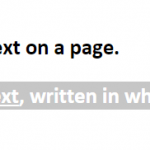White Hat Link Building Services Vs Black Hat: Know The Difference
-
Aaron Gray
- Blogs
-
November 25 , 2020
-
10 min read
Link building is the SEO process of acquiring hyperlinks back to your own site, and when done right, it can provide great long-term returns. However, some link building methods, while quick and easy, can jeopardize your entire website’s rankings. The most critical rule to adhere to when building links is ensuring your backlinks abide by Google guidelines. You could spend weeks devising a sophisticated SEO strategy, but without following these regulations, your hard work will go to waste.
For agencies or individuals looking to add link building into their SEO strategy, this article will provide a run down on the differences between black-hat and white-hat link building methods, as well as how to spot them. So, let’s get started.
What is White-Hat Link Building?
White-hat link building is an approach to building links which carries a low risk to website owners. Generally speaking, the techniques that fit into this category utilize transparent, long-term SEO tactics that align with webmaster guidelines and ultimately, aim to provide beneficial content to other web users.
You’ll have a much lower chance of being penalised when you employ white-hat techniques in comparison to sketchy black-hat methods. Utilising services that offer white-label link building will be the best option for improving your backlink profile and, consequently, your SEO performance.
What do White-hat Link Building Methods Look Like?
Some key white-hat link building methods include:
1. Creation of Unique and Insightful Content
When link building, it’s important you write and create brand new content that hasn’t been used or seen before. Fresh content is particularly important in the indexing process. When Google indexes it with your do-follow backlink, it doesn’t have to compare the piece against duplicate content. This means it won’t need to determine which version is more beneficial to web users. This helps to boost your ranking and SEO.
One key way to test whether your chosen link building service is using unique content for your campaign is to paste the copy into a plagiarism checker like Copyscape. If the content comes back with clashes, aside from the website its published on, this is a strong sign it’s been plagiarised, and black hat techniques are being used. If there’s no additional clashes, the content is likely to be original.
Other things to consider when appraising content for link-building purposes include:
- Does the content offer good advice, tips or information for readers?
- Does the content relate close enough to your website niche and the backlink you’re trying to gain?
- Is the content published on a niche-relevant website?
Example of Plagiarism-free Content
As you can see, this content has no clashes. This means it’s unique.
Example of Plagiarised Content
This content – a description taken from our website – has come back with a match, as Copyscape recognises it’s already published online. This means the content is plagiarised and could hurt your ranking.
2. Backlink on Quality Websites
In the link building world, there’s two types of websites: real websites and Private Blog Networks (PBNs). Private blog networks, as we’ll explain later, are made specifically for hosting links. On the other hand, real websites made by individuals or businesses publish quality content and have solid metrics.
To spot a genuine website from a PBN, here’s some things to watch out for:
- Functionality: Real websites operate properly. They generally have a decent backlink profile and feature a variety of pages, such as services, about us and a blog.
- Domain history: By checking a site’s history, you can find whether the domain is solid, or if it expired and was picked up again – a common tactic employed by PBNs owners.
- Ownership: Using sites like WHOIS to check site ownership will show you whether it’s owned by the original holder or if it’s changed hands multiple times. If the owner is hidden, this is a red flag.
- Content volume: How much content does the site publish? Real websites typically follow a content calendar or will only publish a couple of times per week, whereas poor quality sites and PBNs pump out large volumes of content.
- Backlink profile: Check the backlink profile to see whether the site has a lot of broken links. If it does, it’s more likely to be a PBN. Real websites generally care about broken links and complete regular audits to find and have them repaired.
- Metrics: Analyse metrics and traffic. If the trust flow (TF) and the citation flow (CF) are similar figures and the site receives a decent amount of traffic, it’s most likely a good website. On the other hand, if the TF and CF figures are far apart, that’s a sign the site is of lower quality.
White-hat link building techniques are important as they reduce the risk of your website and links being penalised by search engines. If a service claims to be a white-hat link builder, they should utilise the above methods.
Example of a Quality Website’s Navigation Bar
3. Link Placement on a Variety of Websites
So, you’ve found a service that provides quality, white-hat link building with original content and publishes on reputable websites. You should approve as many links as possible to kickstart your link-building journey, right? Wrong. Many people fall into the trap of wanting to place as many links on sites with similar, strong metrics as possible. In the process, they create a backlink footprint and risk being penalised by search engines.
To avoid forming a footprint, diversify your backlink profile and make sure to:
- Place links on a mix of high and low-authority niche-relevant sites.
- Limit the amount of links you place at a time (e.g. avoid going from zero links to 20).
4. Transparency of Sites Before Publishing
Just as you’d request a preview of a finished product from an offline service provider, you should always inspect websites prior to any link placements going live. A provider that gives you the live link but doesn’t allow you to inspect the site beforehand may be using their own network of websites instead of doing manual outreach.
When buying link placements, it’s important to know whether you’re getting quality links for your money. Thus, it’s a good idea to find a service provider that’ll allow you to view target websites before any links are published. This allows you to approve or reject them so you’re not spending money on something you don’t want, improving your SEO strategies and overall rank.
What is Black-Hat Link Building?

Black-hat link building is the process of using shady SEO tactics that breach search engine guidelines to drive traffic to a website. Years ago, black hat link building services would take advantage of website loopholes in order to rank their sites faster. The problem with black hat seo is search engines have become aware of these bad practices and developed algorithms which detect and penalise websites who actively employ them.
Despite the significant risks involved with these techniques nowadays, people still conduct black hat tactics to boost website rankings quickly, rather than through organic means.
What Do Black-Hat Link Building Methods Look Like?
Black-hat link builders generally use techniques that breach webmaster guidelines in order to gain links for their clients. Some black hat SEO tactics to watch out for are:
1. Private Blog Networks (PBNs)
As mentioned earlier, there are two types of websites a provider can publish on: real websites or private blog networks. PBNs are site networks that are generally designed to make money. These websites host large backlink profiles, which are often spammy, and post bulk content. Other ways you can spot a PBN:
- They may only feature one or two pages, such as a homepage, write for us page and category page.
- They tend to publish an abundance of content and generally have a large backlink profile with many broken links.
- Their domain history will show their site expired and was picked up again by someone else.
- They’ve had multiple website owners in the past.
- They post stock images exclusively, which are shared between other websites that belong to the same site owner.
These are the most common signs of PBNs to look out for when using a link-building provider.
Example of a PBN Navigation Bar
This site is clearly a PBN as it only has a couple of very basic pages, including a write for us button, and is incredibly basic by design.
2. Link Farms
Using and creating link farms is another black-hat technique that should be avoided. Link farms are groups of websites that host a series of links pointing to each other to boost rankings. Most display no content of value or substance. This method was designed to increase the popularity of websites in the group and essentially spam search indexes.
While some link farms appear legitimate at first glance, your backlink and website ranking can still be harmed when connected with them. One clear way to tell if a site is part of a link farm is by checking its PageRank status. If you use a page rank tool to search a website’s domain, link farms will generally show up with hundreds of backlinks but no PageRank. Essentially, the higher the PageRank, the less chance the site is part of a link farm. However, it’s important to note that other factors that may influence why a site’s PageRank is zero, such as:
- The site is new and hasn’t been ranked yet.
- The PageRank hasn’t been updated for some time.
3. Hidden Links and Text
Hidden links and anchor text, often seen in black-hat practices, involve discreetly adding links and anchors within blog content, camouflaging them to appear as regular text. This tactic, known as a form of cloaking, aims to present different content to users compared to what’s shown to search engine crawlers, all in an effort to boost search rankings.
Black-hat link builders may bury these covert backlinks, deceiving website owners who unwittingly publish these hidden links. To check if your link-building provider employs this method, you can copy and paste the content from your live link into a word document, highlight the entire page, and color all text black. If they’re using this tactic, the hidden text will be revealed.
While the allure of hidden text for quick SEO improvements may be tempting, the consequences of such practices can be severe if discovered. Additionally, hidden text is considered spam and can negatively impact the quality of your backlinks in the long run. If your chosen link-building provider engages in these tactics, it’s advisable to seek a new one.
Example of Hidden Text
Take Away
Link building isn’t easy, especially when aiming for effective, Google-friendly backlinks. The choice between black hat techniques and white hat SEO techniques hinges on how backlinks are obtained. When selecting a link-building provider for your agency or business, try multiple options and ensure they employ legitimate white-hat SEO strategies to uphold SEO principles, improve rankings, and evade search engine crawlers. This helps your digital marketing efforts excel while staying Google-friendly.
Subscribe to Our Blog
Stay up to date with the latest marketing, sales, service tips and news.











